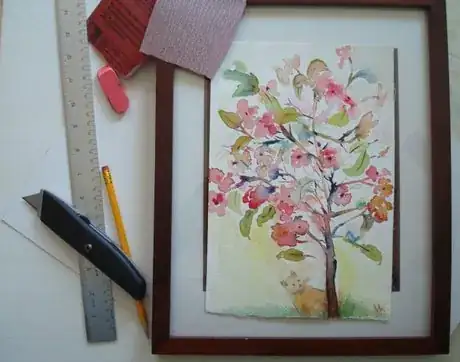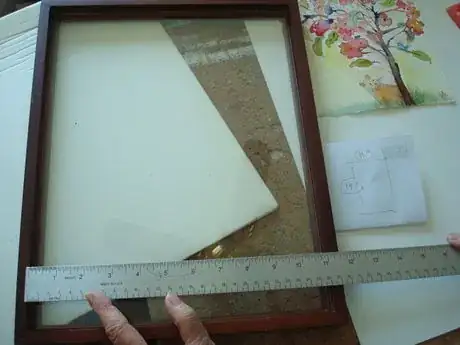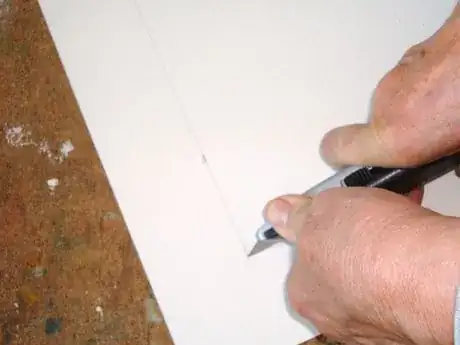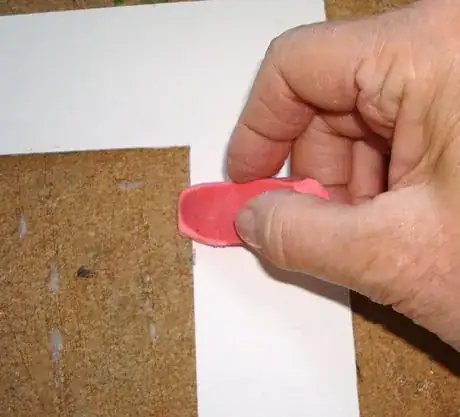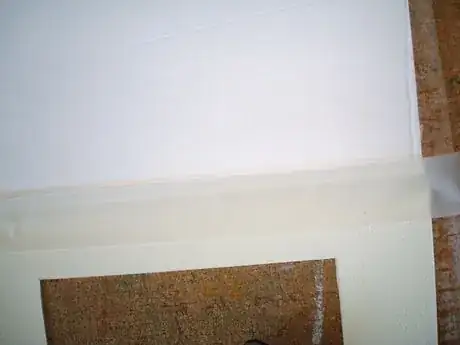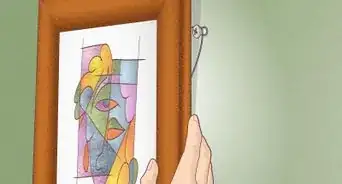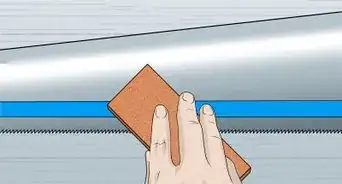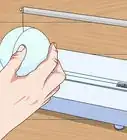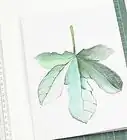This article was co-authored by Virginia Kelley, MA, a trusted member of wikiHow's volunteer community. Virginia Kelley is an artist and art teacher from New York with over 30 years of experience. She has both a Bachelor's and a Master's degree in Art Education from SUNY-Buffalo State and has taught art at the K-12 and college levels. For the last 20 years, she has focused her work and teaching on watercolor.
This article has been viewed 34,619 times.
Learn more...
Matting a picture is easy when you can purchase a pre-cut mat. Faced with a piece of art that doesn't conform to existing commercial standards, knowing how to do it yourself saves the expense and time of having a custom mat cut. Follow these steps to the letter, and you can cut your own professional, hinged mats using the most primitive of tools, a utility knife and metal ruler.
Steps
Planning, Drawing Guide Lines and Cutting the Board to Size
-
1Assemble your supplies. Have close at hand your art work that is to be matted, mat board, cardboard or foam core board for backing, a pencil, eraser, a metal ruler or one with a metal edge, a small piece of fine grain sandpaper or an emery board, and tape.
-
2Find a sturdy surface for mat cutting. Be sure it is larger than the mat you will be cutting and protect it with stiff cardboard. The hard, compressed type of cardboard on the backs of pads of art paper are sturdy and hard to penetrate with knife cuts. Join one or more together with tape to create a larger piece, if necessary.Advertisement
-
3Use only white, pebble surface mat board. Crescent brand can be found in the vertical bins at the craft store, near the frame department.
-
4Utilize the perfect edges on the sheet of new mat board.
-
5Cut the piece you will need from the top right or left corner. Measure the inside of the frame you will be using and, in pencil, lightly mark the cuts to be done on the mat board to that size.
-
6Choose any brand or grade of utility knife. Be sure the blade is new and perfectly sharp. For many types, you will need a screw driver to open the handle to position a new blade.
-
7Keep in mind to always protect the piece you will be using for your mat. If you should make a bad cut, the important part is saved. Align the ruler at your pencil mark and hold it securely against the board with enough pressure to keep it from slipping as you run the knife against it. All of the cuts you will be making will be done slowly, and with a light hand. The hand holding the knife should be relaxed and the knife held loosely. At first, your cut will barely penetrate the mat board. On the second and successive cuts the knife it will fall into the groove you established with the first cut. It will take two more light cuts, to be completely through the board. Turn the board and cut the second side. You might have to approach the table from a different direction in order to keep the proper position for cutting, with the knife cutting away from the good part of the mat, into the center or what will become the opening of the mat.
-
8When you have finished, take the test the piece of mat board to be sure it fits into your frame. If you have measured correctly, it should drop easily into place and be a perfect fit. Make adjustments at this point if necessary.
Cutting the Mat Opening
-
1Place your art work on the mat and visually align it in the center. Mats generally have at least a few inches of white showing around the art piece. If there is less that, find a larger frame.
-
2Use a ruler and measure in from the outside edges of your mat. Determine how many inches on all sides you will need to have the hole in the mat be slightly smaller than the art piece. If there is a difference, traditionally, the bottom edge can be slightly larger. Write those four numbers on a piece of scrap paper for ready reference as you work.
-
3Set your art aside. Measure in from the four outside edges of your mat and make a series of tiny, elongated dots in pencil, plotting the shape of the cuts for the interior of the mat or mat opening.
-
4Cut the corners first. Place the knife on the mat board with the point of the knife exactly aligned with the top corner of the mat and press hard, straight down, to pierce the board. Turn the work and repeat on the second side of the corner. Creating these "L" shapes at each corner will ensure perfect corners in your finished mat. These corner cuts in the board will also be starting and stopping points for your side cuts.
-
5To cut the mat sides, repeat the steps described above. Always cut away from the important part. In this case have your ruler on the mat side and cut toward the center. Use three light cuts to get through the board. Don't attempt to tug or pull the center away. Keep cutting light strokes with the ruler until the center comes away and drops out.
-
6Use sandpaper on rough spots. Sand in one direction inward from outside, or good side of your mat. Don't try to rub, tear or pull any imperfections. Use slow and methodical strokes of sandpaper or emery board.
-
7Erase all pencil lines. Use a pink eraser, an art gum or kneaded eraser. The "pebbled" surface of the mat board makes erasures invisible.
Creating a Hinged Mat
-
1Cut a piece of cardboard to serve as backing. This can be lighter weight and cheaper cardboard or a piece of foam core board. Make it slightly smaller than the mat's outside dimensions. Align the top edge of the backing with that of the mat and tape the two edges with a continuous strip of tape to form a hinge at the top.
-
2Fold the mat and backing closed and tape from side to side on the outside to reinforce the hinge.
-
3Place your art on the backing. Check to see it is aligned perfectly by closing the mat. Open again, and tape the art at intervals with two inch pieces of tape. Strive for neatness and cut, rather than tear these small pieces of tape.
-
4Set the matted piece into the frame and check to see that there is nothing between the glass and the art, such as eraser crumbs, lint or fuzz. Erase again, because new pencil marks will show up now. Check to see if you have signed your work and that the signature is showing. If you cleaned the glass, be sure it is completely dry before closing up the matted art in the frame.
Warnings
- Keep all mat making materials away from children.⧼thumbs_response⧽
- Working with sharp blades it is necessary to remain focused on your task. Keep the hand holding the ruler well back from the edge you will be cutting.⧼thumbs_response⧽
